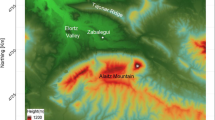Abstract
In the context of CO2 surface exchange estimation, an analysis combining the basic principles of diffusion and scalar conservation shows that the mixing ratio is the appropriate variable both for defining the (eddy covariance) turbulent flux and also for expressing the relationship between the turbulent flux and surface exchange in boundary-layer budget equations. Other scalar intensity variables sometimes chosen, both the CO2 density and molar fraction, are susceptible to the influence of surface exchange of heat and water vapour. The application of a hypsometric analysis to the boundary-layer “control volume” below the tower measurement height reveals flaws in previously applied approaches: (a) incompressibility cannot be assumed to simplify mass conservation (the budget in terms of CO2 density); (b) compressibility alone makes the analysis of mass conservation vulnerable to uncertainties associated with resultant non-zero vertical velocities too small to measure or model over real terrain; and (c) the WPL (Webb et al. (1980) Quart J Roy Meteorol Soc 106:85–100) “zero dry air flux” assumption is invalidated except at the surface boundary. Nevertheless, the definition and removal of the WPL terms do not hinge upon this last assumption, and so the turbulent CO2 flux can be accurately determined by eddy covariance using gas analysers of either open- or closed-path design. An appendix discusses the necessary assumptions and appropriate interpretations for deriving the WPL terms.
Similar content being viewed by others
References
Aubinet M, Grelle A, Ibrom A, Rannik Ü, Moncrieff JB, Foken T, Kowalski AS, Martin PH, Berbigier P, Bernhofer C, Clement R, Elbers JA, Granier A, Grünwald T, Morgenstern K, Pilegaard K, Rebmann C, Snijders W, Valentini R, Vesala T (2000) Estimates of the annual net carbon and water exchange of forests: the EUROFLUX methodology. Adv Ecol Res 30:113–173
Baldocchi DD (2003) Assessing the eddy covariance technique for evaluating carbon dioxide exchange rates of ecosystems: past, present and future. Global Change Biol 9:479–492
Baldocchi DD, Falge E, Gu L, Olson R, Hollinger D, Running D, Anthoni PM, Bernhofer C, Davis KJ, Evans R, Fuentes JD, Goldstein AH, Katul GG, Law BE, Lee Z, Malhi Y, Meyers TP, Munger W, Oechel W, Paw UKT, Pilegaard K, Schmid HP, Valentini R, Verma SB, Vesala T, Wilson KB, Wofsy SC (2001) FLUXNET: a new tool to study the temporal and spatial variability of ecosystem-scale carbon dioxide, water vapor, and energy flux densities. Bull Amer Meteorol Soc 82(11):2415–2434
Baldocchi DD, Hicks BB, Meyers TP (1988) Measuring biosphere-atmosphere exchange of biologically-related gases with micrometeorological methods. Ecology 69(5):1331–1340
Batchelor GK (1967) An introduction to fluid dynamics. Cambridge University Press, Cambridge, 615 pp
Dabberdt WF, Lenschow DH, Horst TW, Zimmerman PR, Oncley SP, Delany AC (1993) Atmosphere-surface exchange measurements. Science 260:1472–1480
Finnigan JJ, Clement R, Malhi Y, Leuning R, Cleugh HA (2003) A re-evaluation of long-term flux measurement techniques. Part I: Averaging and coordinate rotation. Boundary-Layer Meteorol 107:1–48
Fuehrer PL, Friehe CA (2002) Flux corrections revisited. Boundary-Layer Meteorol 102:415–457
Holton JR (1992) An introduction to dynamic meteorology. Academic Press, San Diego, 511 pp
Khvorostyanov VI, Curry JA (1999) Toward the theory of stochastic condensation in clouds. Part I: A general kinetic equation. J Atmos Sci 56:3985–3996
Lee X (1998) On micrometeorological observations of surface-air exchange over tall vegetation. Agric Forest Meteorol 91:39–49
Leuning R (2004) Measurements of trace gas fluxes in the atmosphere using eddy covariance: WPL corrections revisted. In: Lee X, Massman WJ, Law BE (eds) Handbook of micrometeorology, A guide for surface flux measurement and analysis. Kluwer Academic Publishers, Dordrecht, pp 119–132
Leuning R (2007) The correct form of the Webb, Pearman and Leuning equation for eddy fluxes of trace gases in steady and non-steady state, horizontally homogeneous flows. Boundary-Layer Meteorol (in press)
Leuning R, Judd MJ (1996) The relative merits of open- and closed-path analysers for measurement of eddy fluxes. Global Change Biol 2:241–253
Leuning R, Legg BJ (1982) Comments on “The influence of water vapor fluctuations on turbulent fluxes”, by Brook. Boundary-Layer Meteorol 23:255–258
Liu H (2005) An alternative approach for CO2 flux correction caused by heat and water vapour transfer. Boundary-Layer Meteorol 115:151–168
Massman WJ (2000) A simple method for estimating frequency response corrections for eddy covariance systems. Agric Forest Meteorol 104:185–198
Massman WJ, Tuovinen J-P (2006) An analysis and implications of alternative methods of deriving the density (WPL) terms for eddy covariance flux measurements. Boundary-Layer Meteorol 121:221–227
Paw UKT, Baldocchi DD, Meyers TP, Wilson KB (2000) Correction of eddy-covariance measurements incorporating both advective effects and density fluxes. Boundary-Layer Meteorol 97:487–511
Rannik Ü, Keronen P, Hari P, Vesala T (2004) Estimation of forest–atmosphere CO2 exchange by eddy covariance and profile techniques. Agric Forest Meteorol 126:141–155
Webb EK, Pearman GI, Leuning R (1980) Correction of flux measurements for density effects due to heat and water vapour transfer. Quart J Roy Meteorol Soc 106:85–100
Wofsy SC, Goulden ML, Munger JW, Fan SM, Bakwin PS, Daube BC, Bassow SL, Bazzaz FA (1993) Net exchange of CO2 in a mid-latitude forest. Science 260:1314–1317
Xu L-K, Matista AA, Hsiao TC (1999) A technique for measuring CO2 and water vapor profiles within and above plant canopies over short periods. Agric Forest Meteorol 94:1–12
Yi C, Davis KJ, Bakwin PS, Berger BW, Marr LC (2000) Influence of advection on measurements of the net ecosystem-atmosphere exchange of CO2 from a very tall tower. J Geophys Res 105(D8):9991–9999
Author information
Authors and Affiliations
Corresponding author
Rights and permissions
About this article
Cite this article
Kowalski, A.S., Serrano-Ortiz, P. On the relationship between the eddy covariance, the turbulent flux, and surface exchange for a trace gas such as CO2 . Boundary-Layer Meteorol 124, 129–141 (2007). https://doi.org/10.1007/s10546-007-9171-z
Received:
Accepted:
Published:
Issue Date:
DOI: https://doi.org/10.1007/s10546-007-9171-z




